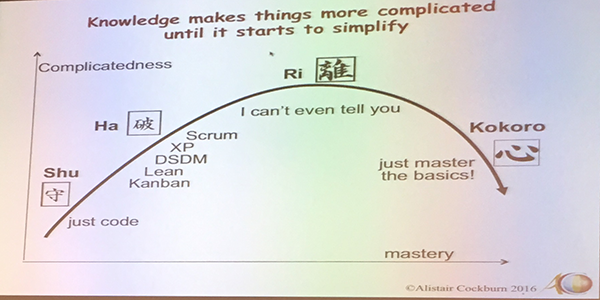We co-hosted an amazing talk from Alistair Cockburn on Tuesday 14 June. He entertained us with a talk where he took shu, ha, ri to another level.

Shu-ha-ri is a Japanese martial art concept that is well-used in our industry. In case you have somehow missed it, it describes the stages a martial arts student progresses through:
- Shu (obey): a student learns the basics from their teacher;
- Ha (digress): students may choose to digress from doing what they are told;
- Ri (separate): they don’t follow techniques as moves are now natural;
We like the concept of shu-ha-ri because it can be used to succinctly explain the levels people go through to achieve mastery of any domain, not just in martial arts.
However, Cockburn is pushing a simple extension after the ri level: “kokoro”. This translates to “heart”, but in an emotional, conceptual and spiritual sense, rather than a literal one about an organ that pumps blood around the body. The “thinking and feeling heart” as Meredith McKinney describes it*. Cockburn’s suggestion is that, once mastery has been achieved, the next stage is a realisation that the fundamentals are what really matter. With agile, Cockburn says that this is collaborate – deliver – reflect – improve. He does go deeper into how this might be achieved, but those four core values of the Agile Manifesto are the kokoro of what we do.
I think this talk made quite an impact on a lot of the audience. Many people (me included) have tried to impress colleagues, students, mentees and clients through a display of knowledge – probably in an attempt to deal with our imposter syndrome issues. Sure, a wide range of knowledge and experience is very useful, but a true master doesn’t need this sort of knowledge gymnastics to prove themselves.
Let’s bring it back to the fundamentals, stop making this more complicated than it needs to be and make it easy for newcomers to start thinking in an agile way.
If you are interested in ideas around models of learning, I’d recommend checking out Wushu and the Dreyfus model of skill acquisition. You can view the video of the event here.
* Reference:McKinney, Meredith. About the title. Kokoro, Netsuke Soseki. New York: Penguin, 2010.

Hi David,
It’s worth noting that ‘Shu, Ha, Ri’ actually comes from Noh (traditional Japanese theatre) which was itself adapted from a similar concept in Chado – the tea ceremony. It was only much later (late 20th century) that the concept became part of the Aikido teaching. The Chinese have a similar system ‘di, ren, tian’. The Dreyfus model of skills acquisition could also be said to be similar, with Shu being stages 1 and 2, Ha being stages 3 and 4, and Ri being stage 5.
Cheers Mr Fox. My knowledge on Japanese theatre (of any kind, not just traditional) is as poor as my knowledge on tea ceremonies and martial arts, so thanks for the clarification. Alistair’s talk has had an unexpected consequence: I’m currently reading Natsume Sōseki’s Kokoro and loving it.